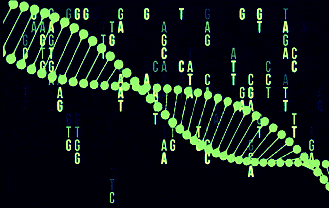Our life depends on the digital information in all its forms: text, video, audio, photo. Its amount increases with every passing day, so data storage devices with bigger capacity, density and long term of use are of great demand. However, it is challenging to store digital information more than 50 years. Yet, scientists have found relatively stable and compact information storage device – it is… (drum roll) DNA! Its properties are ideal for long-term data storing. So, can DNA molecule store your favorite films is HD quality? How long can the information be stored there? Let’s find out.
DNA (deoxyribonucleic acid) is a biological polymer molecule that carries genetic information about the development and functioning of an organism. Almost all living things on the Earth store their genetic information in a form of DNA. It consists of monomers (nucleotides) that are formed of sugar (deoxyribose), nucleobase (adenine, A; guanine G; cytosine, C; thymine, T) and phosphoric acid. An order of nucleotides and nucleobases defines the genetic code: adjacent nucleotides determine amino acid sequence of proteins that regulate all biological processes.
Scientists have learned a lot of DNA properties, thus ,DNA manipulations are widely used in researches and medicine. Genetically modified organisms, vaccines, HIV treatment, gene therapy – all these achievements are contributions of the DNA studying results. DNA is not only a biological compound: in its nature, it is a chemical polymer possessing physical properties. And such famous molecule couldn’t stay out of sight of chemists, physicists, and engineers. You’ll be impressed of the potential use of DNA: it can stabilize nanostructures, store terabytes of information and be an essential component of new age computers.
DNA was suggested as a potential polymer for data storing and its retrieving. Modern information storage devices (books, microfilms, photos, CDs, hard discs or flash memories) have a limited time of existence and are sensitive to environmental conditions (humidity, temperature). DNA is the only data-storage medium that can exist thousand or even million of years and DNA of the ancient fossils is an evidence of such idea. It is stable in the environment; scientists have even found 300,000-year-old mitochondrial DNA from a bear and a human and have sequenced them. Imagine that all human history in a form of text, images, video, and audio can be artificially encoded into DNA molecule and can be stored for our descendants for thousands of years.
Moreover, work with information is based on the binary code (1 or 0) nowadays. Each of these is one bit while eight bits is one byte. DNA in turn has bigger data storing potential because each bit can be coded with four letters (A,G,T,C) but not only two numbers mentioned previously. Synthesized DNA molecule with determined order of nucleotides can encode great amounts of information: 1 zettabyte (billion of terabytes) of data can be accumulated only in a few grams of DNA.
Of course, there are some limitations in using DNA as a memory drive. It takes much time to synthesize long DNA and sequence it. Besides, the price of these manipulations is relatively high and errors can also occur during the chemical synthesis of DNA. But scientists are on the way to overcome these difficulties. At first, to store information, they use thousands of short DNA molecules (up to 200 nucleotides) instead of one or several very long polymers. Second, the cost of DNA synthesis and sequencing is reduced exponentially over a year: the price for one-megabyte encoding is ?$500 (three times less than two years ago) and its retrieval is ?$200. In 2013, a team from the European Bioinformatics Institute reported the successful storage of 739 kilobytes of data in DNA — including a color image, Shakespeare’s 154 sonnets, an excerpt from Martin Luther King’s “I have a dream” speech and the classic 1953 paper on DNA structure by Watson and Crick. Recently scientists from the Institute for Chemical and Bioengineering at ETH Zurich have developed a new improved technic for data encoding and error correction during the DNA sequencing. Furthermore, they increased its storage efficiency, so now DNA within a silicon glass is almost eternal information storage (up to 1 000 000 years at -18°C).
DNA was discovered not only to store information but also to analyze it, therefore, DNA computing is another potential use of DNA in a new way. Recently, scientists at the University of East Anglia have shown that regulated conformational changes in a DNA structure can serve as a molecular switch like diodes or transistors – traditional electronic switches. Another group of scientists have created programmable DNA molecule that functions as GPS navigator for choosing the shortest way. These and other researches show great potential of DNA-based computers that can be cheaper and more effective for solving only complicated and huge tasks. So, don’t even dream to surf the internet or play games on your own DNA-computer.
Evolution have developed an excellent mechanism of accumulation, storage and transferring natural information in a form of DNA. Now science is trying to use these principles in storing the great amount of information for a long time while modern information storage devices cannot provide this ability. Due to high price and continuous writing and reading, this method of data manipulation will be used for storing any information: cultural destinations or scientific papers. DNA will not be used for storing your favorite films or music, it will store the whole world info.









not science fiction, humanity moving into the 21st century